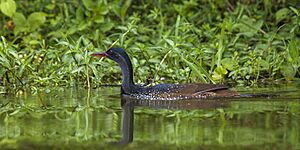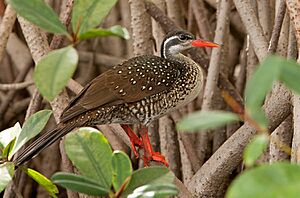African finfoot facts for kids
Quick facts for kids African finfoot |
|
|---|---|
 |
|
| Conservation status | |
| Scientific classification | |
| Genus: |
Podica
|
| Species: |
senegalensis
|
| Synonyms | |
|
Heliornis senegalensis Vieillot, 1817 |
|
The African finfoot (Podica senegalensis) is a cool aquatic bird. It's part of a special bird family called Heliornithidae. This family includes other finfoots and the sungrebe. You can find these birds living near rivers and lakes. They live in western, central, and southern Africa.
Contents
What Does It Look Like?
The African finfoot is a great swimmer. It has a long neck and a sharp beak. Its feet are bright red and lobed, which helps it paddle. The bird's feathers, called plumage, can look different. This depends on where the bird lives. Usually, they are lighter on their belly and darker on their back. Male finfoots are often darker than females. They look a bit like the torrent duck from South America.
Where Do They Live and What Do They Do?
You can find African finfoots in many places across Africa. They like areas with rivers, streams, and lakes. These places must have lots of plants or trees along the banks. This gives them good places to hide. Their homes include forests, wooded savannahs, and even mangrove swamps.
What Do They Eat?
Finfoots eat small creatures that live in the water. These include insects like mayflies and dragonflies. They also eat tiny crabs, snails, fish, and frogs. They are very good at finding food. Sometimes, they even pick prey right off the water's surface. They can also walk and find food on the river banks. This is different from birds like grebes, which they look like but are not related to.
How Do They Behave?
African finfoots are usually seen alone or in pairs. They are very shy and hard to spot. Even bird experts rarely see them! This makes them a special find for bird watchers. Because they hide so well, we don't know if they spend most of their time in the water or on land.
When Do They Have Babies?
The time they lay eggs changes depending on the area. It usually happens during the rainy season. They build a simple nest of twigs and reeds. This nest is usually on a fallen tree branch above the water. The female lays two eggs. She sits on them to keep them warm, which is called incubating. The baby birds leave the nest just a few days after they hatch.
Family Tree
The African finfoot belongs to the Heliornithidae family. The only other birds in this family are the masked finfoot and the sungrebe. Scientists are still learning about how this family is related to other birds.
Are They Safe?
It's hard to know exactly how many African finfoots there are. This is because they are so good at hiding! But they are not thought to be in danger right now. People don't hunt them, and they live in many different places. However, there is a worry for the future. Their homes, called wetlands, are sometimes cleared or changed. Water can also get polluted. Finfoots also don't like being disturbed by people. Because of this, and because their homes are getting broken up, they need to be watched. This will help keep them safe. Right now, there are no African finfoots living in zoos or special care.



